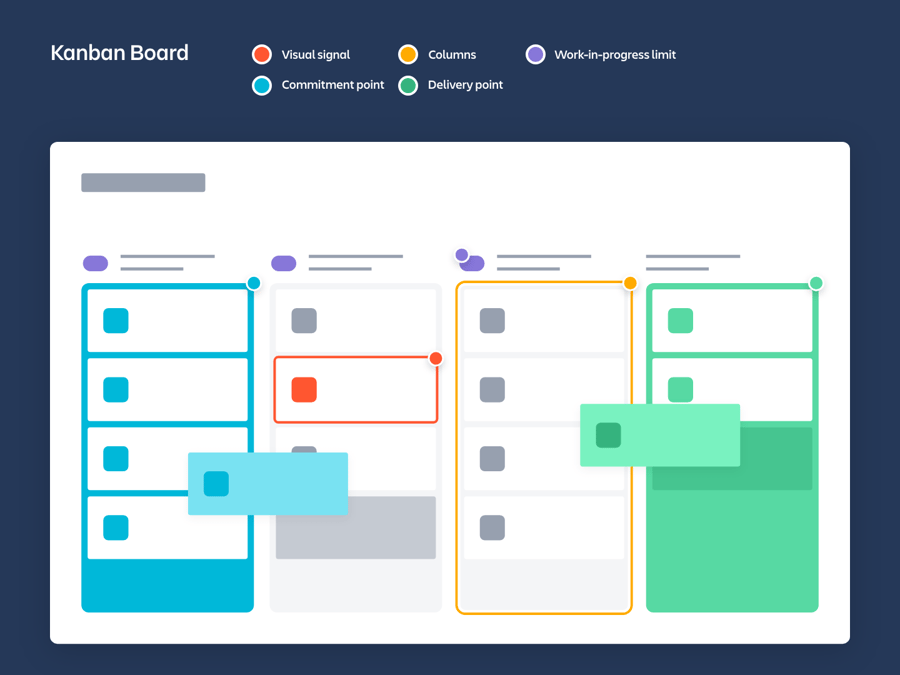Scrum & Kanban: Agile Methodologies for Efficient Teams with Atlassian
Discover the power of Scrum and Kanban in the Atlassian ecosystem. Optimize workflows and collaboration across industries with Atlassian's suite of powerful Agile tools like Jira Software and Trello. Learn how these methodologies, when implemented through Atlassian products, streamline project management, enhance team productivity, and drive successful outcomes.
Get started!Scrum and Kanban are two of the most popular Agile frameworks used by teams worldwide to optimize their workflows, increase collaboration, and deliver high-quality products. Both methodologies share the foundational principles of Agile, emphasizing iterative development, customer feedback, and continuous improvement. However, they differ in their approach to project management and task allocation.
Scrum
Scrum is based on fixed-length iterations known as Sprints, typically lasting two to four weeks. Each Sprint begins with a Sprint Planning meeting, where the team selects a set of user stories to complete during the iteration. The team then holds daily stand-ups to discuss progress, identify potential blockers, and adapt their plan accordingly. At the end of the Sprint, a Sprint Review and Sprint Retrospective take place to showcase the completed work to stakeholders and reflect on the team's performance.
Effective Sprint Planning and Time-Boxed Iterations
Scrum's structured approach enables teams to plan and prioritize work effectively through Sprint Planning sessions. Time-boxed iterations, typically lasting two to four weeks, foster a sense of urgency and promote a sustainable pace for development.
Enhanced Collaboration and Transparency
Daily stand-ups, Sprint Reviews, and Retrospectives encourage continuous communication and collaboration among team members. The Scrum board visualizes the progress of tasks, fostering transparency for stakeholders and enabling timely adjustments to project direction.
Scrum template
Easily plan, track and manage ֵwork across sprints.
Iterate quickly: Release updates, fix bugs, and ship products within defined time periods called sprints.
Increase transparency: See who’s doing what and when, identify blockers early, and keep your team aligned with a single source of truth for all your team’s work.
Manageable workloads: Break down large projects into manageable tasks and milestones to keep your team focused and motivated.
Kanban
Kanban, on the other hand, emphasizes a continuous flow of work with no fixed iterations. Work items move through a visualized workflow on a Kanban board, starting from the "To Do" column and progressing to "In Progress" and finally "Done." The Kanban approach allows teams to pull new work items into their workflow as capacity permits, making it highly adaptable to changing priorities.
Visualized Workflow and Process Improvement
Kanban boards visually represent the flow of work, making it easy to identify bottlenecks and areas for improvement. Continuous improvement is inherent in the Kanban methodology, encouraging teams to evolve their processes and optimize performance continually.
Kanban template
Maximize efficiency by seeing and moving forward the work that matters most.
Increase transparency: Quickly check the status of projects and tasks across teams so you can build better, together.
Prevent blockers: Easily visualize tasks and limit work in progress so that tasks flow smoothly through your workflow.
Stay flexible: Use the template as-is, or customize your workflow to best suit your team’s need. Perfect for today, better for tomorrow.
Scrumban - A Blend of Scrum and Kanban
Scrumban is an Agile hybrid that combines principles from both Scrum and Kanban. It emerges when teams initially following Scrum principles find value in adopting Kanban practices or vice versa. Scrumban retains the time-boxed Sprints from Scrum while incorporating Kanban's pull-based system and continuous flow. It allows for greater flexibility in the planning process and the introduction of new work items as priorities change.
In Scrumban, teams continuously refine their processes, adapting to the demands of the project and evolving customer needs. The combination of Scrum's structured approach and Kanban's adaptability makes Scrumban an excellent choice for teams looking to optimize their Agile practices further.
Comparison of Scrum, Kanban, and Scrumban
| Aspect | Scrum | Kanban | Scrumban |
|---|---|---|---|
| Methodology | Iterative and time-boxed | Continuous flow | Blend of Scrum and Kanban |
| Planning | Fixed-length Sprints | No fixed iterations | Time-boxed Sprints with flexibility |
| Work Allocation | Capacity-based | Demand-based | Pull-based and Continuous flow |
| Flexibility | Low adaptability | High adaptability | Flexible planning and continuous flow |
| Team Composition | Specific roles (Scrum Master, Product Owner, Team) | Flexible team structure | Retains Scrum roles with adaptability |
Agile Excellence Made Easy:
Our Services for Scrum and Kanban
System Implementation
We specialize in expertly implementing Scrum and Kanban systems tailored to your organization's unique needs. Our dedicated team of Agile professionals will seamlessly integrate these methodologies into your existing workflows. From setting up Jira Software and configuring Scrum boards to designing efficient Kanban workflows, we ensure a smooth transition to Agile practices. With our system implementation services, you'll experience enhanced collaboration, increased productivity, and streamlined project management, empowering your teams to deliver exceptional results.
Process Consulting
Our process consulting services provide the expertise needed to optimize your Scrum and Kanban practices. Our Agile consultants assess your current processes, identify areas for improvement, and design customized solutions to overcome challenges. We offer hands-on training and coaching, equipping your teams with the skills and knowledge to excel in Agile methodologies. Through our process consulting, you'll foster a culture of continuous improvement, adaptability, and innovation, ensuring long-term success in your Agile transformation journey.
Comparison with Traditional Methods
Agile methodologies like Scrum and Kanban stand in stark contrast to traditional project management approaches, such as the Waterfall model. While traditional methods follow a sequential and rigid process, Agile embraces adaptability, continuous improvement, and customer collaboration. In Waterfall, project requirements are defined upfront, and each phase (e.g., analysis, design, development, testing) must be completed before progressing to the next. This approach often leads to long development cycles, delayed feedback, and difficulty accommodating changes.
In contrast, Scrum and Kanban embrace iterative and incremental development. Scrum's time-boxed Sprints and Kanban's continuous flow allow teams to deliver small, valuable increments of work rapidly. By encouraging regular inspection and adaptation, Agile methodologies foster a more responsive approach to customer needs and market changes. Agile teams work collaboratively, with stakeholders involved throughout the process, ensuring that feedback is addressed promptly, and the end product aligns with customer expectations.
Industries & Teams
Scrum and Kanban, two popular Agile methodologies, find extensive use across various industries and teams, optimizing project management and enhancing collaboration. These methodologies have proven to be effective in industries such as IT, software development, marketing, product development, and many more. Teams in Legal, Finance, HR, and other departments have also embraced Scrum and Kanban to improve their processes and deliver quality results.
Software used for Scrum and Kanban:

BigPicture - Project Management & PPM
Atlassian Jira
Atlassian Confluence
Trello
STAGIL Work Templates for Jira

Timesheets by Tempo - Jira Time Tracking
Scrum and Kanban in Your Industry
Embrace the transformative potential of Scrum and Kanban in your industry. Whether you're in Legal, Finance, HR, IT, Marketing, or Healthcare, these Agile methodologies bring unparalleled benefits to your workflows. In the Legal sector, Scrum ensures precise project management and timely resolution of cases, while Finance teams expedite financial analysis and planning with time-boxed iterations. HR experiences seamless recruitment and onboarding, and IT achieves faster software delivery using Kanban's optimized development lifecycle. Marketing benefits from Kanban's enhanced campaign management, and Healthcare streamlines patient care and operations. Revolutionize your processes, foster collaboration, and elevate performance with Scrum and Kanban, tailored to your industry's unique needs.
Best Practices and Tips
Successful Scrum and Kanban adoption require careful planning and a commitment to Agile principles. Here are some best practices and tips to ensure a smooth implementation and maximize the benefits of these methodologies:
Team Composition
Assemble cross-functional teams with diverse skills and expertise to promote collaboration and reduce dependencies. The ideal Scrum team comprises a Scrum Master, Product Owner, and Development Team, while Kanban teams can be more flexible in their structure.
Visualize Work
Embrace the power of visual management by using physical or digital boards to track work items. For Scrum, this involves a Scrum board with columns representing the various stages of the Sprint. In Kanban, a Kanban board visualizes the flow of work through its stages.
Limit Work in Progress (WIP)
Enforce WIP limits to avoid overwhelming the team and maintain a smooth workflow. This approach enhances focus, reduces context-switching, and uncovers bottlenecks.
Emphasize Continuous Improvement
Foster a culture of continuous improvement by holding regular retrospectives. Encourage team members to share insights, discuss challenges, and implement actionable improvements.
Facilitate Effective Communication
Promote open and transparent communication within the team and with stakeholders. Regular stand-up meetings in Scrum and regular Kanban meetings facilitate real-time information exchange.
Overcoming Challenges
Common challenges during Scrum and Kanban adoption include resistance to change, lack of clear goals, and difficulty estimating work accurately. Address these challenges by providing proper training, setting clear expectations, and establishing supportive feedback loops.

Need help choosing the proper framework or implementing this in your organization?
Our agile consultants will be glad to help! Whatever you choose - Scrum, Kanban, or Scrumban - catworkx will help you maximize the benefits, leveraging cutting-edge Atlassian tools.
The initial consultation is non-binding and free of charge.










.png?width=64&height=64&name=ITIL%20Foundation%20(2).png)





